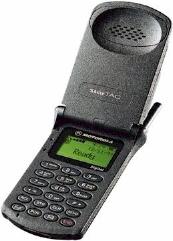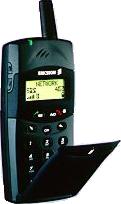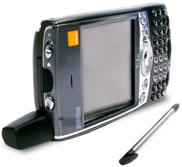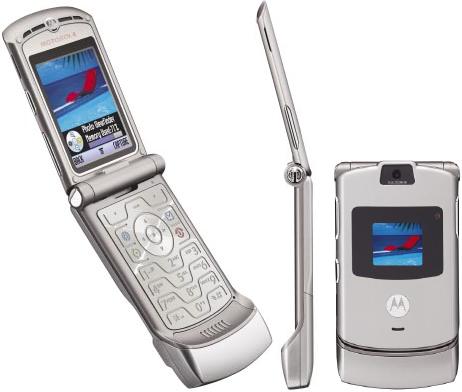|
|
 subscribe
subscribe
|
 subscribe subscribe
|
cell phones
Friday 23 May 2003
Just as they change, I realize how much we take for granted, and how much we assume will be remembered. Cell phones, for example, are on my mind at the moment. I've always been at the trailing edge of adopting cell phones, usually because of the cost. So I was a year behind folks willing to pay thousands, and later hundreds, of dollars to be first. But there I was, in the years before the computer revolution touched most households, with my ears to primitive cell phones. I'm jotting down my personal history because I've just made a transition (about which I'll chat later) and I wanted to remember this branch of the evolution of technology.
 In the beginning there was the brick, the so-called transportable. Then came the portables, so-called because they were hard to transport. Finally came the pocket phones. And as soon as we were happy with them, the world changed.
In the beginning there was the brick, the so-called transportable. Then came the portables, so-called because they were hard to transport. Finally came the pocket phones. And as soon as we were happy with them, the world changed.

 Analog was how things started. From the earliest radio-telephones you might have seen on 1950s police dramas to the early 1980s, it was analog.
Analog was how things started. From the earliest radio-telephones you might have seen on 1950s police dramas to the early 1980s, it was analog.
My first cellular telephone was the Motorola DPC 950, shown at left. It was a big, clunky affair, but it was portable and had a reasonable battery life (battery shown at right). These phones had their history in military hardware; they were made to be rugged. One could hammer nails into a wall with this thing. It survived drops from ear to sidewalk without any effect.
If memory serves, Motorola was enjoying a 99.9999 per cent manufacturing quality at the time, "six sigma" or some-such. In any case, the phone wasn't small, but it was amazingly designed and implemented, and I was thrilled to have it.
 It lasted a good long time, and I wound up switch to my next telephone only because I changed providers, each of which supported particular phones on their network. (I'm hoping this will sound barbaric to readers in the not-too-distant future.)
It lasted a good long time, and I wound up switch to my next telephone only because I changed providers, each of which supported particular phones on their network. (I'm hoping this will sound barbaric to readers in the not-too-distant future.)
The Motorola StarTAC, my next phone, was something out of Gene Rodenberry's Star Trek. It flipped open, like a Communicator, It was terribly lightweight and small enough to be lost in a pocket.
Alas, it was nowhere as rugged as its predecessor. It still survived multiple drops to the sidewalk, but started failing in numbers so large that our provider refused to service them after a while, forcing us to switch en masse to another brand, Nokia, if memory serves.
I was pretty unimpressed by this turn of events, first from an engineering point of view, and then from a corporate police standpoint. It seemed so messy, so shoddy, so haphazard. Inconvenient as it was, it didn't come at a bad time in relation to the steady evolution of the technology. I'd been using analog telephones for long enough, now it was time to move into the next age of telecommunications, even if it meant switching providers (and losing my old phone number) in the process.
It was time to become digital.
My next phone was a digital StarTAC, which provided unbelievable clear communications (no subtle radio hum in the background) but which was limited to areas of digital cellular coverage. Think urban. Very urban. Much of San Francisco was covered, but very few smaller towns. During a 1997 Arizona business trip, for example, there was absolutely no cellular coverage in Phoenix, despite it being one of the main centers for Motorola. The irony is delicious. Luckily this phone was able to fall back to analog, and I returned to scratchy conversations. But at least I could be chatting.
 What that phone died I was faced with the choice of which new phone to replace it. Even the cheapest phones were over a hundred dollars, and none had a particularly spectacular lifespan. It was rather dispiriting.
What that phone died I was faced with the choice of which new phone to replace it. Even the cheapest phones were over a hundred dollars, and none had a particularly spectacular lifespan. It was rather dispiriting.
In a fit of pique I bought a bundle of five used Ericsson phones in an eBay auction for $25, total. All I had to do was pop my SIM (Subscriber Identity Module) chip into one of these phones and I was off.
These Ericssons weren't excellent in any way, but they worked, and that was that. There were nicer phones to be had, and certainly more interesting ones, but I had gotten burned out on the planned obsolescence and poor engineering. Getting five telephones, five chargers, and freedom from the vicious tyranny of the marketing cycle was a darned good thing for me.
Those Ericssons lasted me a good long while. They were impessively unimpressive; but having something inelegant which just got the job done was a pretty refreshing thing.

 I might still be using those phones except the world changed again, this time on the sales front. Most of the big cellular providers had decided that it was better to charge in a buffet style than an a la carte style. What had been more pay-as-you-use became "give us a big monthly fee and we'll fake you out by giving you lots of minutes when you can't use them" service. One offer included 5000 night and weekend minutes. Most of us are awake during daylight hours.
I might still be using those phones except the world changed again, this time on the sales front. Most of the big cellular providers had decided that it was better to charge in a buffet style than an a la carte style. What had been more pay-as-you-use became "give us a big monthly fee and we'll fake you out by giving you lots of minutes when you can't use them" service. One offer included 5000 night and weekend minutes. Most of us are awake during daylight hours.
So when Deutsche Telekom decided to break into the American market as T-Mobile, they started with a rather good offer with more than reasonable "anytime minutes". The offer was so good that it was price-worthy enough for Rose and I to each have a phone. And the phones were free, after a rebate. So it came to pass that two of the Motorola V 60 phones came into our lives. Not much bigger than my thumb, with a Lithium Ion battery (as opposed to the Nickel Cadmium batteries of the earlier phones), they were a pretty good deal. They were also the first tri-band "world phones" I'd used, ones which could find a GSM band in the Americas, in Japan, and in Europe (each of which uses a different operating frequency).
 Then my involvement with dedicated telephony hardware came to a quick end; a Handspring Treo 180 took over. The Treo 180 was a wonderful bit of hardware, a blending of cell phone and Palm PDA organizer. There are a lot of good things such a convergence gives, especially being able to keep a synchronized version of all your contacts (phone numbers, addresses), calendar schedule, to do lists, and memos. Sadly the Treo was a poorly-engineered device, with corners cut, and worst of all, exceedingly poor support from Handspring (and later, after acquisition) and Palm. When confronted with a groundswell of complaints about broken hinges and poor wiring Handspring/Palm offered so-called "service" at a price higher than a new unit could be acquired from eBay. T-Mobile ate all the replacement costs, as they evidently got stiffed too. Hare are the details about the "Handspring Treo 180".
Then my involvement with dedicated telephony hardware came to a quick end; a Handspring Treo 180 took over. The Treo 180 was a wonderful bit of hardware, a blending of cell phone and Palm PDA organizer. There are a lot of good things such a convergence gives, especially being able to keep a synchronized version of all your contacts (phone numbers, addresses), calendar schedule, to do lists, and memos. Sadly the Treo was a poorly-engineered device, with corners cut, and worst of all, exceedingly poor support from Handspring (and later, after acquisition) and Palm. When confronted with a groundswell of complaints about broken hinges and poor wiring Handspring/Palm offered so-called "service" at a price higher than a new unit could be acquired from eBay. T-Mobile ate all the replacement costs, as they evidently got stiffed too. Hare are the details about the "Handspring Treo 180".
 Autumn 2005 found me buying a brand new Palm Treo 600 on eBay. After the engineering fiasco that was the Handspring Treo 180 - and the subsequent horror of support from Handspring and Palm - I vowed never to enrich those companies by buying hardware from them directly.
Autumn 2005 found me buying a brand new Palm Treo 600 on eBay. After the engineering fiasco that was the Handspring Treo 180 - and the subsequent horror of support from Handspring and Palm - I vowed never to enrich those companies by buying hardware from them directly.
Luckly the aftermarket for phones obsoleted (in this case by the Treo 650 and the rumored 700) means I can lighten a company's stock at a price much closer to that of a nice evening out on the town, which is more my price-point. Here are the details about the Palm Treo 600.

| Have you found errors nontrivial or marginal, factual, analytical and illogical, arithmetical, temporal, or even typographical? Please let me know; drop me email. Thanks! |